Effect on vision ...
| Lighting fundamentals |
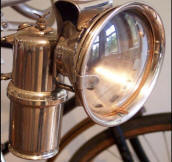 |
Headlamps have evolved from oil burning coach lamps and carbide acetylene lamps via perfectly functional seven inch parabolic reflector tungsten-halogen sealed beam units to glitzy designs using high intensity 6,500k Light Emitting Diodes (LED) and Laser Diodes. |
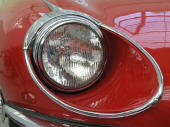 |
|
|
Supposedly "Glare-free"
intelligent light systems with image analysis have been developed (e.g. Matrix, IntelliLux,
Adaptive High Beam Assist). Matrix LED systems use multiple LEDs
that can be individually controlled to adapt the light pattern based on
road conditions and oncoming traffic and can be adapted to change
direction and brightness. However to sense oncoming vehicles, the drivers are momentarily blinded and unless the road is billiard table smooth, they also blind drivers when functioning. |
 |
||
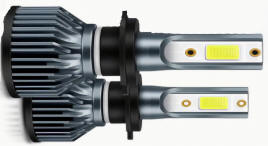 H7 and H4 7.5 watt LED headlamp bulbs |
Whilst permitted in the EU, these systems are NOT approved in the USA.. A 7.5-watt LED bulb can replace a 50-watt halogen bulb while providing equivalent brightness and last up to 50,000 hours . Laser diodes are the current vogue which emit an intense, bluish-dominant light (~450 nm). Dynamic "area light modulation" can be implemented using a mirror matrix. |
Messages such as a "STOP!" or navigation arrows or complex animations can be projected onto the road. Information about possible braking deceleration or braking pressure can be generated. Taillights can project a warning triangle into fog particles. The triumph of LED lights (and gimmicks) seems unstoppable.
|
The result: Glare for all road users, both motorised and non-motorised. |
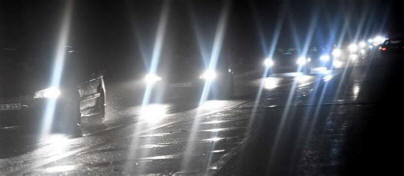 |
White LED's used on vehicles emit light at 6,500k, close to the eye damaging blue ultra-violet end of the spectrum (despite using a UV absorbing glass envelope, some UV light escapes). It is this "blueness" that causes untenable, blinding disability glare, increased scattering, fogging and obscuration of vision due to chromatic aberration.
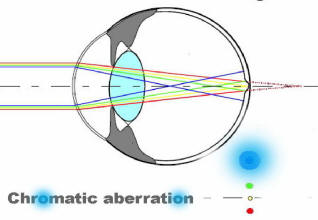 Blue light causes Chromatic aberration = poor eye focus |
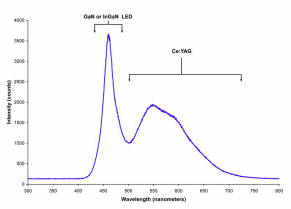 White 6,500k LED peaking near the eye-damaging UV end of the spectrum |
Although a driver can have 20:20 vision, increasing age correlates with glare sensitivity and prolonged retinal recovery times. Drivers who have had eye surgery, e.g. retinal light damage, macular degeneration or lens opacities are particularly affected.
The retina uses colour sensitive cones in the day and rods at night. Daytime cones are sensitive to colours (central visual acuity) and essential for hazard perception (sharp vision). Studies show that at low light levels, the human eye does not function fully in the normal photopic region and its colour sensitivity shifts to the scotopic conditions (Purkinje effect). The curve's peak is shifted towards the blue end of the spectrum thus making the eye more sensitive to 6,500k LED lights at night.
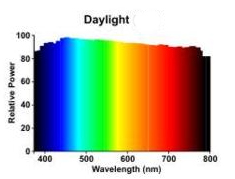 Visible daylight ranges from the blue 380 nanometer to red 780 nanometer wavelengths. Below ~ 400nm is the eye and skin- damaging Ultra-Violet band |
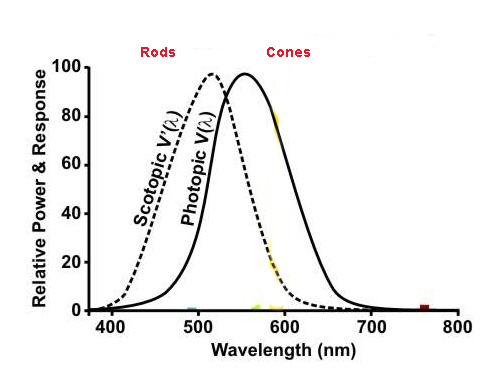 Scotopic vs. Photopic sensitivity in the eye's response at night-time between rods and daytime cones |
Sensory physiological and Neurophysiologic Effects
Visual short-term memory may suffer from capacitive de-compensation (overflow) due to excessive visual stimuli just above threshold of the central visual field and the peripheral field (not necessarily dazzling or glaring) causing "Distraction Blindness". This results in severe cognitive and perceptual disorders with potential fatal consequences for more vulnerable less conspicuous road users.
Reference: Expert Opinion
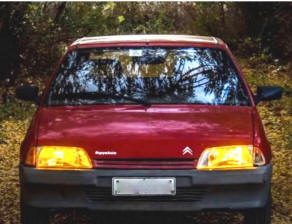 Selective Yellow Headlights | The Authorities and UNECE lighting "experts" have
failed to consult professional Ophthalmologists on safe lighting
standards. The French understood the need to prevent blinding and thereby improving contrast vision (filtering the ‘blue blur’, a chromatic aberration halo) by using "Selective Yellow" headlamps between 1936 and 1993. France changed to yellow/white tungsten- halogen lights to comply with UNECE rules. |
On the roads, when life-safety is at risk why do motor manufacturers deliberately blind other drivers under the guise of safety by focussing light directly into their eyes?
 Extract from Hella's Daytime Running Light brochure |
History
Volvo introduced the concept of Daytime Running Lights (DR)L initially in the early 1960's, initially with dim headlamps and then with brighter 18watt "position" lights (called side-lights in the UK ). When Sweden converted to driving on the right in 1967, all vehicles used dipped (or low beam) headlamps to reduce risk of collisions.
LED headlights were used on Audi R8 and Lexus LS600h models in 2006/7 with most manufacturers offering LED's by 2010/11. From 2011 DRL become mandatory on new vehicles in Europe, the USA followed.
In 2011 Volvo introduced touch screens, a recent publication says are a driver distraction.
The EU research organisation SWOV Factsheet claimed 15% less fatal accidents and 10% less injury accidents from DRL and the UK Dft claimed 6%, in reality:
Flawed EU research studies used slides in a
laboratory rather than real lights! Government and Local
Authorities seem to spend our taxes by making life more difficult
for motorists thus creating a negative more aggressive and dangerous
frame of mind. We have seen tyre and suspension damaging humps,
speed cameras sited to maximise revenue rather than safety, now it
seems permitting motorists to blind each other and kill vulnerable
road users is official policy. Who knows the cumulative affect of
disability glare on a long journey?
Conclusion:
If Authorities and Road Safety Experts reverted to making roads safer by positive measures e.g.:-
Engineering Improvements
Advanced driver training
Regular Eyesight tests
We would not need blinding lights !
We continue the fight to persuade Manufacturers and Authorities to stop this escalating Lightmare!
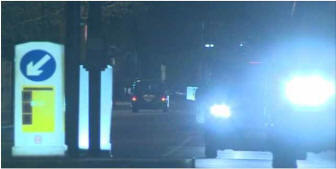
Conclusion:
If Authorities and Road Safety Experts reverted to making roads safer by positive measures e.g.:-
Engineering Improvements
Advanced driver training
Regular Eyesight tests
We would not need blinding lights !
We continue the fight to persuade Manufacturers and Authorities to stop this escalating Lightmare!




